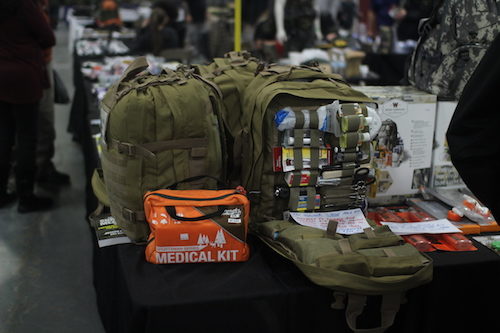Should We Start Preparing for an Apocalypse?

What would be your downfall in the first 180 days after an apocalyptic event? Dehydration? Injury? A pacemaker malfunction? Much depends on the flavor of the cataclysm, and of course, whom you ask.
Bob Gaskin speaks to an overflowing crowd about society-ending events at the Indianapolis Survival and Greener Living Expo. Gaskin is a Marine and the founder of Black Dog Survival School. Attendees have come to hear his advice on prepping, and many of them take notes.
According to Gaskin, the end of the world as we know it could be caused by a variety of circumstances, but he believes it will likely happen soon. An economic collapse, EMP (electromagnetic pulse), natural disasters, or nuclear war could all trigger the end of ‘polite society,’ he says. A ubiquitous theory among preppers is that the electrical grid will be taken out for weeks or months, causing a breakdown of industry and services.

Gaskin is also a vendor at the expo, but he isn’t plugging his products. He stresses the importance of learning survival skills like cold-weather camping and defense in addition to material preparations. “We’ve bought more stuff instead of learning to overcome the things we fear,” he says.
The event is thrown by RK Prepper Shows, which puts on survival expos throughout the South and Midwest. Its vendors sell guns, knives, medical kits, MREs (Meals Ready-to-Eat), radiation detectors, and a host of other prepper paraphernalia. Seminars on water purification and seed-saving are scheduled as well.
Television shows like Doomsday Preppers and Doomsday Bunkers — both premiered in 2012 — depict preppers as paranoid types ripe for ridicule. In typical reality T.V. fashion, the shows’ characters are paraded for round mockery, causing the Times‘ Neil Genzlinger to denounce “how offensively anti-life these shows are, full of contempt for humankind.” Gaskin thinks as much about the media’s portrayal of preppers as well. In fact, survivalists of all stripes express that you’d have to be erroneously optimistic to not prepare. Are they setting themselves up to have the last laugh?
Tim McDaniels, a professor who specializes in decision sciences and risk analysis at the University of British Columbia, says it is sensible for anyone to be prepared for likely hazards. The time and resources invested in “prepping” can turn preparedness into a lifestyle, however, and it can be difficult to predict if stockpiling rations at such a scope will ever be worth the trouble. McDaniels said, “You can imagine conditions in which prepping might pay off, but the preparations of any one person or family or community have limited duration. There’s nothing you can do to protect yourself forever from these kinds of failures or disasters. We can’t create ultimate long-term protection.”

Professor McDaniels lives in Vancouver, therefore he has a contingency plan for earthquakes. This sort of preparedness wouldn’t make sense for someone living in Kansas or Florida, however. He says the way in which you prepare for disasters should be tied to your region.
That’s perfectly reasonable, but what about an all-encompassing disaster? Take an electromagnetic pulse, for example.
An EMP is thought to be capable of mass power outages. Proponents of EMP-preparation have said this could be caused by a nuclear weapon detonated high in the atmosphere. Newt Gingrich has popularized the theory over the years, but several scientists have called such an attack unlikely or theorized that an EMP could not produce such drastic or sustained damage to the power grid.
A solar flare, however, might do the trick. This space weather event is characterized by a release of energy from the sun — another kind of EMP — and it has happened before. The Carrington Event, on September 1, 1859, was a solar flare that produced visible auroras around the world. Telegraph networks sustained damage, but it was nothing compared to the chaos that could ensue if a similar event were to happen today. The energetic particles and coronal mass ejection from a solar flare could disable “everything that plugs into a wall socket,” according to NASA. The implications on travel, industry, medical services, and virtually everything else would be devastating in our technological society. A similar flare occurred in July 2012, but it missed the earth. The odds of one hitting the Earth by 2022 was calculated as 12 percent in 2014, and we will probably only get an advance warning of about 12 hours if it does. Maybe it wouldn’t be such a bad idea to store away some canned beans.
The big question, according to Professor McDaniels, is how long it would take to recover from such a solar storm: “We have an integrated grid that helps us cope with switch failure or downed transmission lines. The integrated grid means that those problems can spill over from one utility to another, but it also means we have power from elsewhere to rely on. If we had a massive problem like where the electrical grid of North America is tremendously adversely affected by some sort of space-based radiation, who knows what the recovery is for that.” NASA estimates the cost of the Carrington Event with today’s electrical reliance could be over $2 trillion.
Keeping some necessities stored is obviously a good idea, but for how long could you possibly defend them if push came to shove?
In David Williams’ recent novel, When the English Fall, an Amish community finds themselves uniquely prepared to weather a devastating solar flare because they never relied on electricity in the first place. The story’s Amish protagonist discovers, however, that unless all of society’s basic needs are being met, the have-nots will soon come after the haves with violent intent. In a similar situation, how would the most well-prepared individuals protect themselves from the desperate masses?
Bob Gaskin’s prepping philosophy is different than many in the game: he doesn’t believe in turning people away in a post-apocalyptic future. To prove this, he gives out his Tennessee address during his presentation. “We don’t just prep for ourselves,” he says, “Food, water, fire, shelter, first aid, hygiene for a couple hundred people that we haven’t even met yet.” This is in stark contrast to the secretive, ammo-wielding stockpiler that is stereotypical of the prepping community.
Some preppers have plans for avoiding marauders. Of course, firepower would help, but it might be a losing game. Another strategy would be to draw as little attention to oneself — and one’s stash — as possible. “If other houses are looted, you make your house look looted,” says a nuclear prepper, “If other people are starving, act like you’re starving too.”

There are many contingencies to consider, of course, like climate change, cyberattacks, and epidemics. All in all, there appears to be no shortage of potential apocalypses. Even if the title “doomsday” isn’t warranted, compounding natural disasters can wear out government relief with the right timing.
Just this year, the Federal Emergency Management Agency found itself overloaded with the victims of Hurricanes Harvey, Irma, and Maria. Puerto Rico’s power grid is operating at around 70 percent three months after Hurricane Maria hit the U.S. territory, and reports from CNN and The New York Times have found that over 1,000 deaths could be attributable to the storm. FEMA’s director, Brock Long, has expressed the need for Americans to become more prepared for disasters, particularly after 2017’s devastating hurricane season. FEMA’s online guide for emergency preparedness covers in-depth recommendations — from shutting off utilities to evacuation to cleanup — for the most probable emergencies.
Whether the future holds a cataclysmic solar flare or a particularly alarming thunderstorm, it is important to have some sort of plan. If you find comfort in preparing a bug-out bag and a desert shelter made of shipping containers, you’re not alone.
The prepping community, like any other, serves to unite its members with common goals and philosophies. For Gaskin, prepping, survival training, cold-weather camping — it’s all about love: “I do stuff like this because I love my wife, children, and grandchildren.” In this sense, prepping is a devoted — albeit grave — labor, a gesture of posterity for the people most important to you.
There is also, seemingly, a love of the lifestyle. The survivalist industry has given way to plenty of fun gadgets, from water purification straws to biomass camp stoves. Presumably, no one in their right mind hopes to one day subsist on reconstituted beef stroganoff and daily water allotments. But, like camping and homesteading, there can be a thrill in self-reliance. Prepping might seem futile if it wasn’t so fun.
Tips for Basic Preparedness
- Learn first aid and CPR. The American Red Cross provides training and certification.
- Know how to shut off your utilities.Water, gas, and power may require disconnection in the event of disaster.Make sure everyone in the household is aware of proper procedure.
- Keep a basic preparedness kit in the home, office, and car. Maintain the kit as needed, and keep in mind your unique needs.
- Have an evacuation plan. This should include a plan for receiving emergency alerts and communication with loved ones.
- Store important documentson a secure drive or cloud. Identification, medical records, and insurance policies for the whole family can bekept securely easily with a variety of storage and cloud apps.
Visit www.ready.gov for more information.